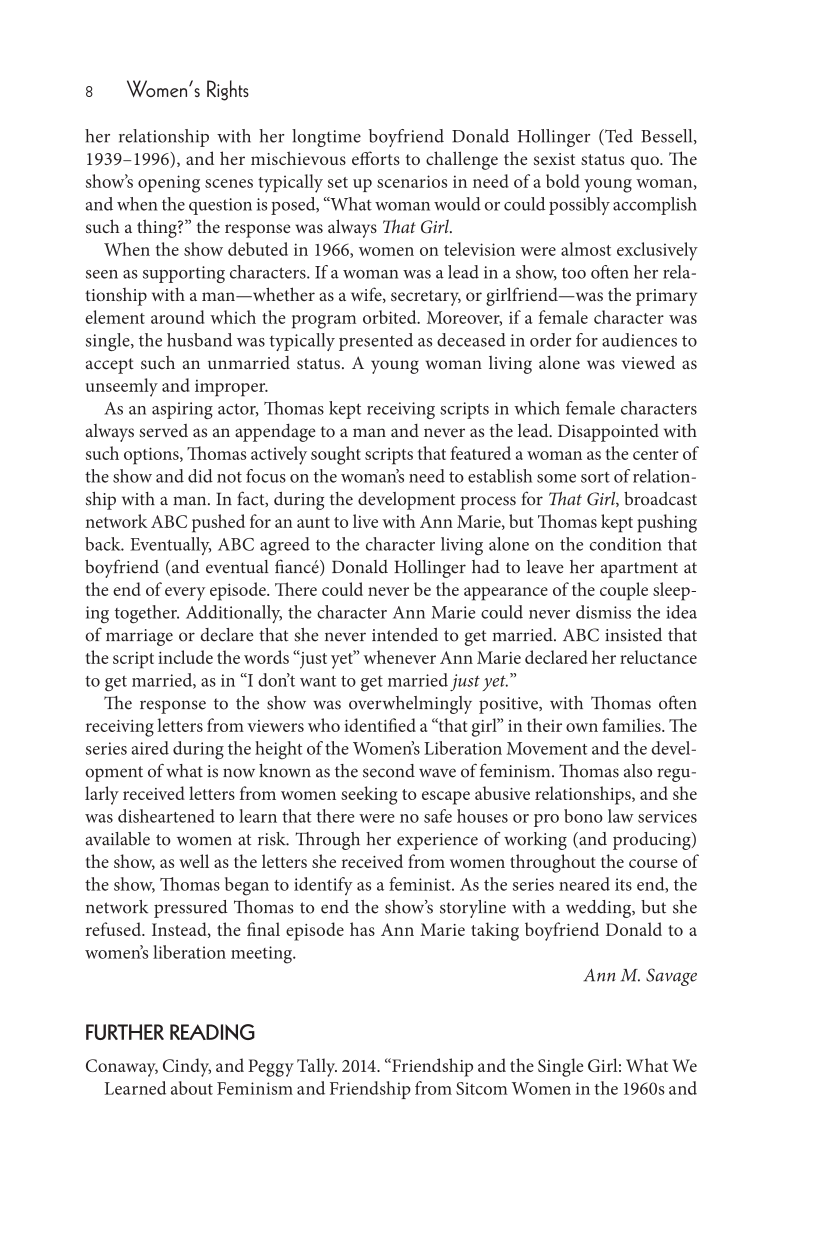8
Women’s Rights
her relationship with her longtime boyfriend Donald Hollinger (Ted Bessell,
1939–1996), and her mischievous efforts to challenge the sexist status quo. The
show’s opening scenes typically set up scenarios in need of a bold young woman,
and when the question is posed, “What woman would or could possibly accomplish
such a thing?” the response was always That Girl.
When the show debuted in 1966, women on television were almost exclusively
seen as supporting characters. If a woman was a lead in a show, too often her rela-
tionship with a man—whether as a wife, secretary, or girlfriend—was the primary
element around which the program orbited. Moreover, if a female character was
single, the husband was typically presented as deceased in order for audiences to
accept such an unmarried status. A young woman living alone was viewed as
unseemly and improper.
As an aspiring actor, Thomas kept receiving scripts in which female characters
always served as an appendage to a man and never as the lead. Disappointed with
such options, Thomas actively sought scripts that featured a woman as the center of
the show and did not focus on the woman’s need to establish some sort of relation-
ship with a man. In fact, during the development process for That Girl, broadcast
network ABC pushed for an aunt to live with Ann Marie, but Thomas kept pushing
back. Eventually, ABC agreed to the character living alone on the condition that
boyfriend (and eventual fiancé) Donald Hollinger had to leave her apartment at
the end of every episode. There could never be the appearance of the couple sleep-
ing together. Additionally, the character Ann Marie could never dismiss the idea
of marriage or declare that she never intended to get married. ABC insisted that
the script include the words “just yet” whenever Ann Marie declared her reluctance
to get married, as in “I don’t want to get married just yet.”
The response to the show was overwhelmingly positive, with Thomas often
receiving letters from viewers who identified a “that girl” in their own families. The
series aired during the height of the Women’s Liberation Movement and the devel-
opment of what is now known as the second wave of feminism. Thomas also regu-
larly received letters from women seeking to escape abusive relationships, and she
was disheartened to learn that there were no safe houses or pro bono law services
available to women at risk. Through her experience of working (and producing)
the show, as well as the letters she received from women throughout the course of
the show, Thomas began to identify as a feminist. As the series neared its end, the
network pressured Thomas to end the show’s storyline with a wedding, but she
refused. Instead, the final episode has Ann Marie taking boyfriend Donald to a
women’s liberation meeting.
Ann M. Savage
FURTHER READING
Conaway, Cindy, and Peggy Tally. 2014. “Friendship and the Single Girl: What We
Learned about Feminism and Friendship from Sitcom Women in the 1960s and

















































































































































































































